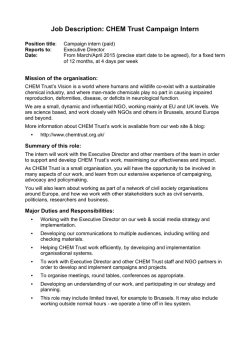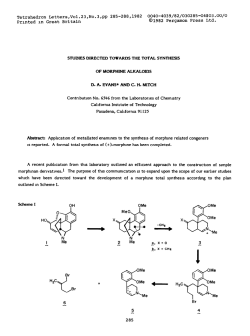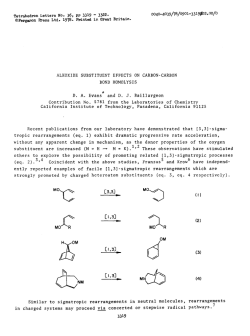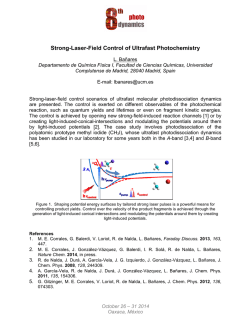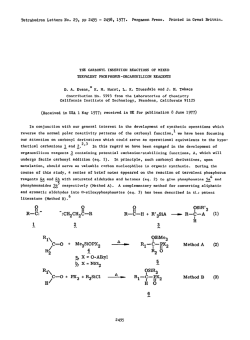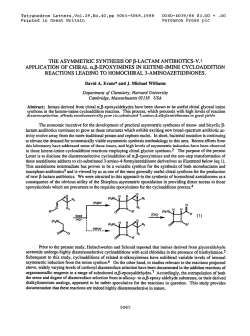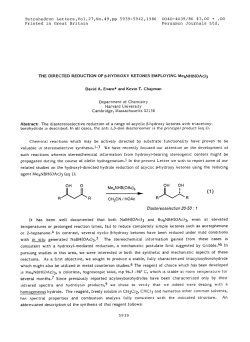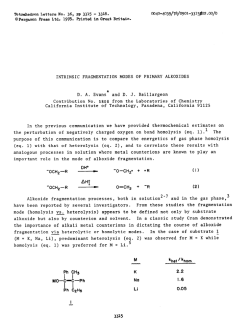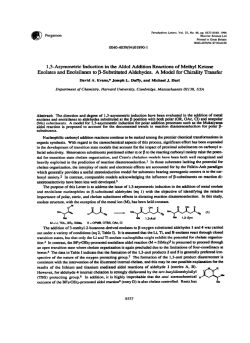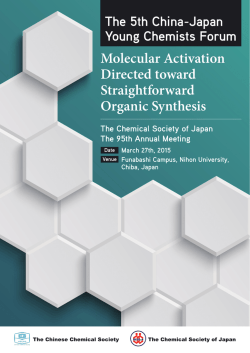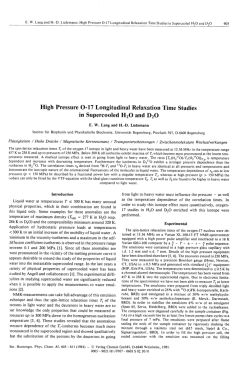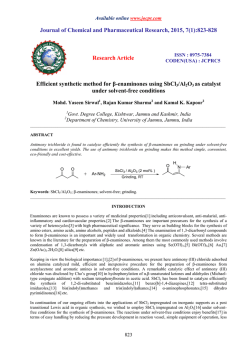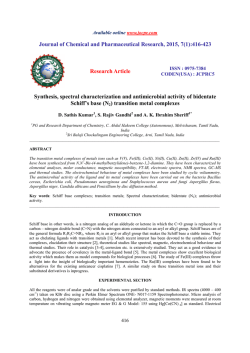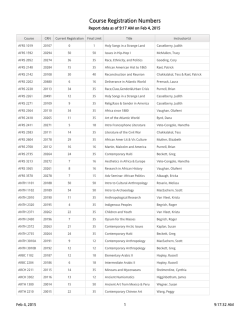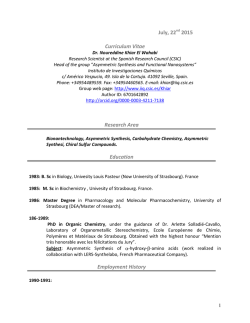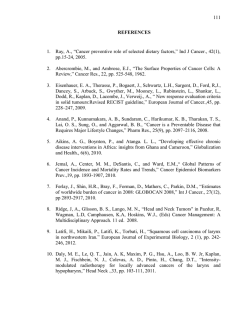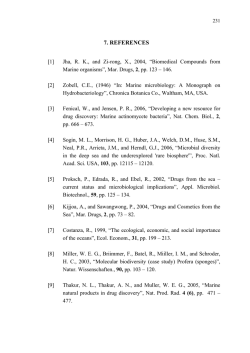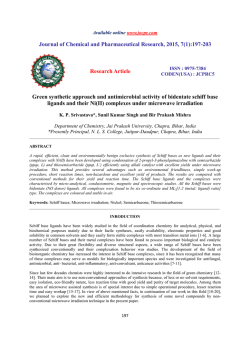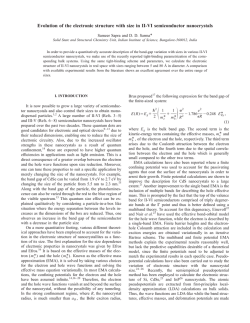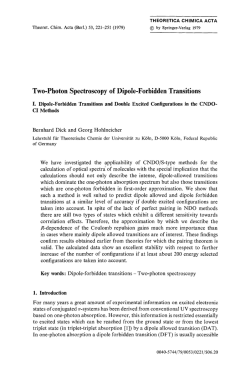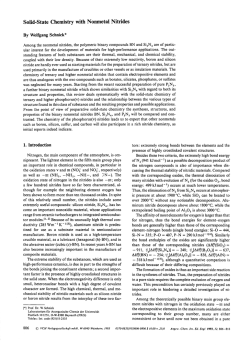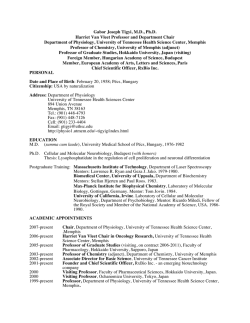
Recent advances in the synthesis of β
Available online www.jocpr.com Journal of Chemical and Pharmaceutical Research, 2015, 7(1):774-780 Review Article ISSN : 0975-7384 CODEN(USA) : JCPRC5 Recent advances in the synthesis of β-lactum derivatives using nitrone cycloaddition reactions Bhaskar Chakraborty Organic Chemistry Laboratory, Sikkim Government College, Gangtok, Sikkim, India _____________________________________________________________________________________________ ABSTRACT Synthesis of β-lactums are always most attractive and challenging to a synthetic organic chemist. Various routes for the synthesis of β-lactum derivatives have been reported in the literature. In this review, our endeavour is to accumulate few important reports on the synthesis of β-lactums and their further applications so as to assist researchers who intent to pursue research in this field. Keywords: β-lactum, Kinugasa reaction, catalysts, biological activity _____________________________________________________________________________________________ INTRODUCTION The β-lactums are one of the best known and extensively investigated heterocyclic ring systems as a result of both their biological activity as antibiotics [1-5] and their utility as synthetic intermediates [6]. Among the different synthetic approaches for the preparation of β-lactums [1-5], the Kinugasa reaction [7] has been largely employed in the current practice of β-lactum synthesis in organic chemistry. Intensive research has generated numerous methods of synthesizing the β -lactam skeleton [8]. Commonly, the lactam ring is formed through either ketene-imine cyclizations [9] (the Staudinger reaction) or ester enolate imine condensations [10-12] (the Gilman-Speeter reaction). REVIEW Nitrone cycloaddition reactions are found to be versatile method for the synthesis of a wide variety of β-lactam derivatives (the Kinugasa reaction). A number of noteworthy strategies have been described, almost all of which rely upon the generation of chiral, nonracemic precursors, followed by formation of the four-membered ring [1-5; 6]. In its first description [13] the Kinugasa reaction involved the reaction of copper (I) phenylacetylide with nitrones to produce β-lactams (Scheme 1). The reaction was performed in anhydrous pyridine at room temperature under nitrogen atmosphere and with short reaction times (from 30 min to 1 h); after hydrolysis and workup, the exclusively cis products were obtained in good yields (from 51.2 to 60.2%). Interestingly, the use of copper (I) phenylacetylide as the reagent was critical, as the reaction of alkynes with nitrones affords pyrrolinediones or isoxazolines [13]. 774 Bhaskar Chakraborty J. Chem. Pharm. Res., 2015, 7(1):774-780 ______________________________________________________________________________ R1 R2 N+ 1 - Ph 2 O R1 H R2 N Py Ph Cu H R1 H R N O Ph H 2 O H 3 4 1 4a :R = Ph, OMeC6H4, O-ClC6H4 4b : R2= Ph, O-ClC6H4 Scheme 1. Synthesis of beta lactums by Kinusaga reaction Recently, some of the contributions in the synthesis of β-lactum have attracted synthetic chemists for their novelty [14-16]. Neumaier et al [14] have shown synthesis of 18F labeled β-lactums using Kinugasa reaction (Scheme 2). N O ; CuI O O N Phenanthroline O MeCN, 900C, 10 min F18 F18 Scheme 2. Synthesis of labeled bicyclic β-lactums using Kinugasa reaction Zhang et al [15] have shown bifunctional N-heterocyclic carbine catalyzed highly enantioselective synthesis of spirocyclic β-lactums (Scheme 3). . Ph O Boc R Ar2 N BF4 Boc O N Ph OTBS Ar2 Ar1 C C Ar1 Ph N C N 10 mol % H H H upto 99% ee Scheme 3. N-heterocyclic carbene catalysed cycloaddition of ketenes with aldimines Rominger et al [16] have shown recently an efficient approach for the synthesis of functionalized β-lactums through a sequential cyclization reaction. Diversity oriented synthesis, good to excellent yields easy workup and short reaction times are the advantages of this procedure In 1993 in a preliminary communication and in 1995 in a full paper, Miura and co-workers reported [17,18] an interesting modification in the original protocol for the Kinugasa reaction based on the reaction of phenylacetylene (5) with a series of C, N-diarylnitrones (6) in the presence of catalytic amounts of copper iodide and potassium carbonate. In an extension of these results, Miura and colleagues described the first examples of the asymmetric intermolecular Kinugasa reaction with chiral ligands [17]. For this purpose bisoxazolinetype ligands (11–13) were selected. 775 Bhaskar Chakraborty J. Chem. Pharm. Res., 2015, 7(1):774-780 ______________________________________________________________________________ Me Me O O O O N N Me Me N N Ph R R Ph 13 11 : R = iPr 12 : R = tBu With stoichiometric amounts of compound 11, the reaction of alkyne 5 with nitrone 6 (Scheme 4) provided βlactams 8a,b in 45% yield and in a 35:65 ratio; each pure isomer showed a 40% ee; increasing the amount of CuI to 1 mmol resulted in 68% ee. Chiral ligands 12 and 13 generated similar products with enantiomeric excesses of 67% and 45%, respectively. After some experimentation it was found that for the same reaction, the slow addition of the phenylacetylene (5) to a mixture of nitrone 6, CuI (0.1 mmol), and 11 (0.2 mmol) afforded a selectivity of 57% ee. When catalysts 12 and 13 were used under these conditions, copper (I) phenylacetylide precipitated preventing further reaction. Ph O- Ph H Ph 5 N CuI-ligand N+ 6 Ph K2CO3/DMF Ph H R2 C 7 N Ph O Ph 8 Ph 8a : R1=H, R2=Ph 8b : R1=Ph, R2=H N PhCH2COOH H 10 R1 Ph Ph 9 Scheme 4. The Kinusaga reaction according to Miura et al In 1997 and 1998 in their first two contributions in this area Basak et al. described the synthesis of the cis-β-lactams 16 by the Kinugasa reaction of the corresponding nitrones 2 and alkynyl alcohols 14, followed by acetylation of the intermediate alcohols 15 (Scheme 5) [19,20]. Compound 16 was then hydrolyzed with pig pancreatic lipase (PPL) to provide enantiomerically pure 2-azetidinone compounds. More recently, Basak et al. reported an asymmetric version of the Kinugasa reaction using Evans's oxazolidinone as a chiral auxiliary [21]. Accordingly, precursor 17 was synthesized and submitted to reaction with nitrone 18, providing mixtures of trans- and cis β-lactams (19 and 20, Scheme 6), both in enantiopure form and with a stereoselectivity in the range of 95%. The absolute configuration at these centers was assigned by X-ray structure analysis of compound 19 (Scheme 4). R1 R (CH2)n 14 n =1,2,3 1 O OH H R2 - N CuI + N 2 R2 DMF, ET3N R3On(H2C) O H Ac2O Et3N Scheme 5. The Kinusaga reaction as reported by Basak et al 776 15: R3=H 16:R3=Ac Bhaskar Chakraborty J. Chem. Pharm. Res., 2015, 7(1):774-780 ______________________________________________________________________________ Ph Ph S Ph - O N C H S O + N Ph O CuI O N DMF, ET3N O 18 17 N O 19 Ph Ph S N O N Scheme 6. Asymmetric Kinusaga reaction with chiral auxiliary O 20 O Finally, they demonstrated, as had been previously proposed [19,20], that the cis isomers isomerize to the trans isomers upon treatment with base (nBuLi) at low temperature. However, they did not attempt to remove the chiral auxiliary from the intermediates to give the free, enantiomerically pure β-lactams. In 2002 Lo and Fu reported the first completely diastereo- and enantioselective catalytic Kinugasa reaction, using the chiral-ligand strategy [22]. This was possible with the sterically hindered base N,N-dimethylcyclohexylamine and new C-2 symmetric planar-chiral bis(azaferrocene) ligands. Under Miura's conditions [23], the coupling of phenylacetylene (5) with N,α-diphenylnitrone (21, Ar=R=Ph) and catalytic amounts of copper chloride led to moderate stereoselection. With catalyst 23 the formation of β-lactams 24 (Scheme 7) proceeded with excellent cis diastereoselectivity (95:5) and good ee (from 67 to 85%). - O R + N 1-2.5% CuCl (R,R) 23 O R N CyNM2, MeCN, 00C Ph 5 Ar 69-91% 21 Ph 24 Ar Cis (95.5) 67-85% ee Scheme 7. Asymmetric Kinugasa reaction according to Lo and Fu. Cy=cyclohexyl. Based on the pioneering work of Kinugasa et al [24], Miura et al [25], and others [26,27], Ryo Shintani and Gregory C. Fu described a copper/ bisazaferrocene-catalyzed method for the asymmetric coupling of alkynes with nitrones (the Kinugasa reaction; [Scheme 8). This mild approach to the generation generation of β-lactams is very attractive owing to its convergence, its high functional-group tolerance, and the ready availability and stability of alkynes and nitrones. Shintani et al also developed intramolecular Kinugasa reactions, ideally with a chiral catalyst, with a view to preparing enantioenriched bi- and polycyclic β-lactams. They have reported a copper/phosphaferrocene– oxazoline catalyst mediates asymmetric intramolecular Kinugasa reactions to produce two new rings with very good stereoselectivity. Furthermore, they establish one of the presumed intermediates in the catalytic cycle (C in Scheme 8) can be intercepted with an electrophile to generate an additional C_C bond and a quaternary stereocenter. 777 Bhaskar Chakraborty J. Chem. Pharm. Res., 2015, 7(1):774-780 ______________________________________________________________________________ R1 R R1 R H catalytic Cu1 upto 93% ee (C6H11)2NMe, MeCN N+ - R2 O R2 O N (Eq 1) R1 R Cu1 catalyst base N+ - N H+ +[Cu] R2 O R2 O R1 R H H+ R1 [Cu] H R R1 N+ - O 2 R N [3+2] R2 N O [Cu] R2 [Cu]O [Cu] c B A R1 R R Scheme 8. Outline of a possible mechanism for the Kinugasa reaction The proposed mechanism for the Kinugasa reaction is illustrated in Scheme 8 [28–31]. It is believed that the terminal alkyne is converted into copper acetylide A in the presence of CuI and a base e.g., (C6H11)2NMe) [6], and that A participates in a [3+2] dipolar cycloaddition with the nitrone. The resulting heterocycle B then rearranges to afford the conjugate base of a β-lactam (enolate C). Protonation (e.g., by [(C6H11)2NHMe]+) furnishes the desired product and releases the copper catalyst. It has been observed from the study that the utility of the Kinugasa reaction would be further enhanced if it is possible to intercept intermediate C by adding an electrophile to the reaction mixture. Shintani et al also demonstrated that an intramolecular Kinugasa reaction can be used to prepare fused tricyclic ring systems efficiently with very good levels of enantioselectivity in the presence of a planar-chiral Cu/phosphaferrocene–oxazoline catalyst (Scheme 9). I CuBr (5%) 3.0 eqiv N+ - Ph(Me3Sio)C=CH2 (2.0 eqiv) KOAc (1.0 eqiv) O MeCN, RT Ar 2 Ar = p-carboethoxyphenyl Scheme 9 778 N O Ar 85% ee 76% yield Bhaskar Chakraborty J. Chem. Pharm. Res., 2015, 7(1):774-780 ______________________________________________________________________________ In 1976, Ding and Irwin reported on the scope and limitation of the Kinugasa reaction in a full paper [32], showing that under the general experimental conditions [28], mixtures of cis and trans-β-lactams were always obtained in different ratios (from 1:1 to 12:1), the cis- β- lactam 3 being the major diastereomer in most cases; the extent of formation of trans-β-lactam 4 (Scheme 10) seemed related to the ease of isomerization at C-3 under the basic conditions, and ultimately to the type of substituents at this position. These authors also proposed the first mechanism for the Kinugasa reaction (Scheme 9), which is still accepted today. In 1986, overlooking Kinugasa's seminal report Sandhu and colleagues described the reaction of copper (I) phenylacetylide with benzoyl-Ntolylnitrone in pyridine, rendering only one compound, the trans-1-tolyl-3-phenyl-4-benzoylazetidin-2-one, in 88% yield [30]. H L L O L OHL H H L Cu L Ph Ph Cu L L Cu(OH)L3 Cu L Ph O O R1 N+ R1 4 ON R H R2 HC N+ H R2 R2 H O Ph N N R1 H 3 Ph O Ph R1 2 R H O H R2 R1 Ph N R1 R2 H O N H 4 R2 Scheme 10. Mechanism for the Kinusaga reaction proposed by Ding and Irwin Recently reported diastereoselective synthesis of β-lactum derivatives was carried out by Chmielewski and coworkers where minor product of the mixture of diastereomer was not isolated [33]. O +N - O O CuI, Et3N O O H H MeCN 30 hr, 46% N O diastereomeric ratio : 90:10 (minor pdt was not isolated) Scheme 11 In a recently published work, we have reported that α-chloro nitrones can also be used as a precursor for the synthesis various β-lactum derivatives [34]. Further work is in progress. CONCLUSION In summary, the Kinugasa reaction is a simple, but efficient protocol for the synthesis of β-lactums in racemic or enantiomerically pure form, with attractive features that include ready availability of the starting material (alkynes and nitrones), convergence, and high functional-group tolerance. The recently described new aspects in the Kinugasa reaction nicely complement the number of methods known and published for the synthesis of enantiomerically pure β-lactams [4]. 779 Bhaskar Chakraborty J. Chem. Pharm. Res., 2015, 7(1):774-780 ______________________________________________________________________________ Acknowledgements We are pleased to acknowledge the financial support from the Department of Science & Technology, Government of India, New Delhi (grant no:SR/S1/OC-34/2011). REFERENCES [1] AR Katritzky; CW Rees; EFV Scriven, Comprehensive Heterocyclic Chemistry (II-Ed. Pergamon, New York), 1996, chap. 1, 18–20. [2] I Ojima; F Delaloge, Chem. Soc. Rev. 1997, 26, 377-384. [3] I Ojima, Acc. Chem. Res. 1995, 28, 383-388. [4) PA Magriotis, Angew. Chem. 2001, 113, 4507-4510. [5] PA Magriotis, Angew. Chem. Int. Ed. 2001, 40, 4377-4381. [6] A Bruggink, Synthesis of β-Lactam Antibiotics Chemistry, Biocatalysis and Process Integration-(Ed.. Kluwer, Dordrecht, Netherlands), 2001. [7] M Kinugasa M; S Hashimoto S, J. Chem. Soc. Chem. Commun, 1972, 466-472. [8] MI Page, The Chemistry of β-Lactams (Ed, Chapman Hall: New York), 1992. [9] C Palomo; JM Aizpurua;, I Ganboa;, M Oiarbide, Eur. J. Org. Chem, 1999, 3223-3236. [10] H Gilman; M Speeter, J. Am. Chem. Soc, 1943, 65, 2255-2259. [11] DJ Hart; DC Ha, Chem. Rev, 1989, 89, 1447-1451. [12] M Benaglia; M Cinquini; F Cozzi, Eur. J. Org. Chem, 2000, 563-568. [13] C Ahn; JW Kennington; P DeShong, J. Org. Chem, 1994, 59, 6282-6287. [14]DB Zlatopolskiy, P Krapf; R Richarz; H Frauendorf; MF Mottaghy; B Neumaier, Chem. European J, 2014, 20, 4697-4699. [15] MH Zhang; HZ Gao; S Ye, Org. Lett, 2014, 16, 3079-3082. [16] E Ghabraie; S Balalaie; S Mehrparvar; F Rominger, J. Org. Chem, 2014, 79, 7926-7930. [17] K Okuro; M Enna; M Miura; M Nomura, J. Chem. Soc. Chem. Commun, 1993, 1107-1110. [18] M Miura; M Enna; K Okuro; M Nomura, J. Org. Chem, 1995, 60, 4999-5003. [19] A Basak; T Mahato; G Bhattacharya; B Mukherjee, Tetrahedron Lett, 1997, 38, 643-648. [20]A Basak; G Bhattacharya; HMM Bdour, Tetrahedron, 1998, 54, 6529-6533. [21] A Basak; SC Ghosh; T Bhowmick; AK Das; V Bertolasi, Tetrahedron Lett, 2002, 43, 5499-5502. [22] MMC Lo; GC Fu, J. Am. Chem. Soc, 2002, 124, 4572-4576. [23] K Okuro; M Enna; M Miura; M Nomura, J. Chem. Soc. Chem. Commun, 1993, 1107-1112. [24] M Miura M; Enna; K Okuro; M Nomura, J. Org. Chem, 1995, 60, 4999-5004. [25]Their original report describes the stoichiometric reaction of a copper acetylide with a nitrone: M Kinugasa; S Hashimoto, J. Chem. Soc. Chem. Commun, 1972, 466-470. [26] M Miura; M Enna; K Okuro; M Nomura, J. Org. Chem. 1995, 60, 5005-5008. [27]For examples of applications of the Kinugasa reaction by others, see: a) LK Ding; WJ Irwin, J. Chem. Soc. Perkin Trans 1, 1976, 2382-2387; b) DK Dutta; RC Boruah; JS Sandhu, Indian J. Chem, 1986, 25B, 350-356; c) DK Dutta; RC Boruah; JS Sandhu, Heterocycles, 1986, 24, 655-659; d) A Basak; G Bhattacharya; HMM Bdour, Tetrahedron, 1998, 54, 6529-6534; e) A Basak; SC Ghosh; T Bhowmich; AK Das; V Bertolasi, Tetrahedron Lett, 2002, 43, 5499-5504. [28]C Ahn; JW Kennington; P DeShong, J. Org. Chem, 1994, 59, 6282-6288. [29]M Kinugasa; S Hashimoto, J. Chem. Soc. Chem. Commun, 1972, 466-469. [30]DK Dutta; RC Boruah; JS Sandhu, Heterocycles, 1986, 24, 655-659. [31]DK Dutta; RC Boruah; JS Sandhu, Indian J. Chem. 1986, 25B, 350-354. [32]LK Ding; WJ Irwin, J. Chem. Soc. Perkin Trans. 1, 1976, 2382-2388. [33]S Stecko; A Mames; B Furman; M Chmielewski, J. Org. Chem, 2009, 74, 3094-3098. [34]B Chakraborty, Greener chemistry on the synthesis and cycloaddition reactions of novel α-chloro nitrones (Amazon.com), 2011, Book (ISBN 978-3-8454-2926-7, LAP LAMBERT Academic Publishing GmbH & Co. KG Dudweiler Landstraße 99, 66123 Saarbrücken, Germany. 780
© Copyright 2026
